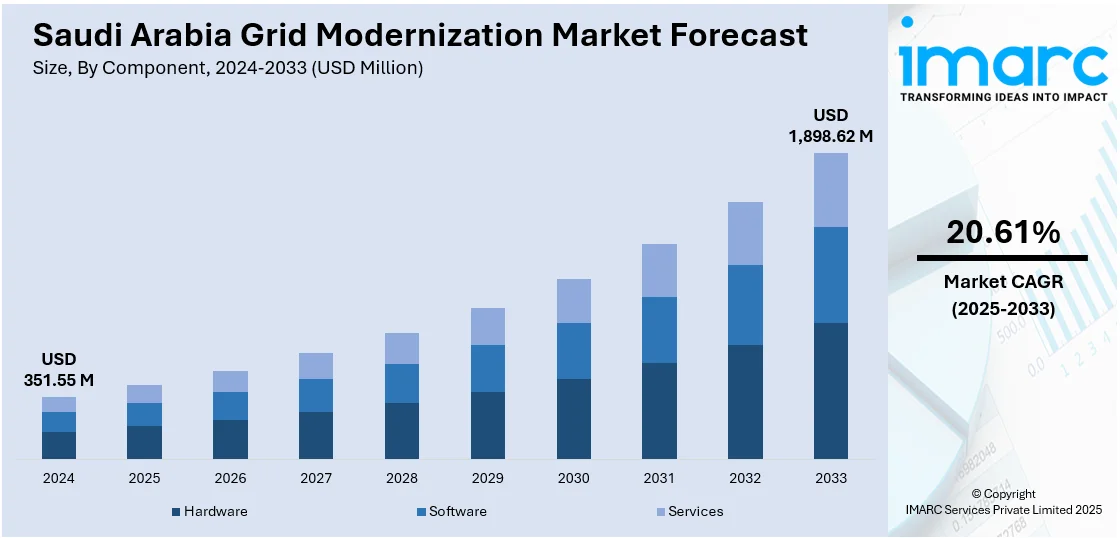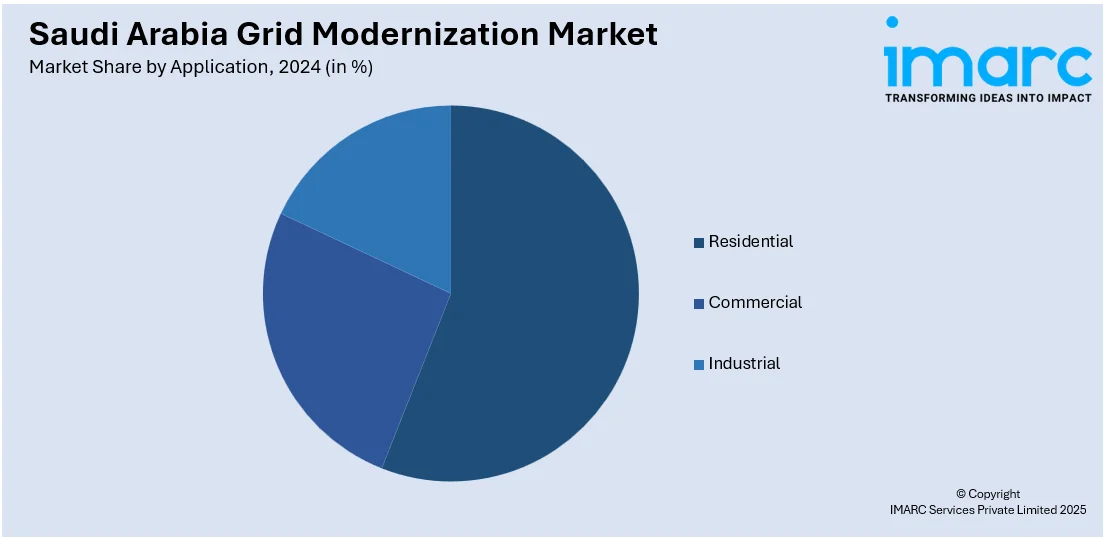
Saudi Arabia Grid Modernization Market Size, Share, Trends and Forecast by Component, Application, End-User, and Region, 2025-2033
Saudi Arabia Grid Modernization Market Overview:
The Saudi Arabia grid modernization market size reached USD 351.55 Million in 2024. Looking forward, IMARC Group expects the market to reach USD 1,898.62 Million by 2033, exhibiting a growth rate (CAGR) of 20.61% during 2025-2033. The market is driven by Vision 2030 and economic diversification programs. Also, climate-induced peak load demand and industrial expansion are fueling the product adoption. Additionally, renewable mega-projects and hydrogen development require intelligent grid systems. Policy backing, advanced load management, and infrastructure built for extreme conditions are some of the factors positively impacting the Saudi Arabia grid modernization market share.
|
Report Attribute
|
Key Statistics
|
|---|---|
|
Base Year
|
2024 |
|
Forecast Years
|
2025-2033
|
|
Historical Years
|
2019-2024
|
| Market Size in 2024 | USD 351.55 Million |
| Market Forecast in 2033 | USD 1,898.62 Million |
| Market Growth Rate 2025-2033 | 20.61% |
Saudi Arabia Grid Modernization Market Trends:
Extreme Climate Conditions and Load Management
Saudi Arabia’s desert climate, with prolonged heatwaves and extremely high cooling demand, places a heavy seasonal burden on the electricity grid. Grid modernization initiatives are focused on ensuring year-round grid stability, especially during summer months when electricity demand peaks due to air conditioning loads. Advanced load forecasting, dynamic voltage regulation, and automated demand response systems are gaining adoption to manage this variability. The need for high operational resilience, fault detection, and rapid restoration systems has accelerated investment in predictive maintenance tools, substation automation, and AI-integrated monitoring platforms. On February 25, 2025, GE Vernova announced plans to expand its GESAT facility in Dammam to locally manufacture high-voltage gas-insulated switchgears, strengthening Saudi Arabia’s domestic grid equipment capabilities. It also revealed increased production at the GEMTEC site to advance grid automation and digitalization, supporting a more resilient and efficient national power network. In addition, GE Vernova signed a new MOU with Saudi Electricity Company to deploy GridOS® software and develop a Regional Center of Competency in Riyadh. These adaptations are highly specific to the Kingdom’s geographic and climatic profile and do not follow a one-size-fits-all model applied elsewhere, thereby contributing to the overall Saudi Arabia grid modernization market growth.

Renewable Mega-Projects and Hydrogen Ambitions
Saudi Arabia is implementing some of the world’s largest renewable energy projects, such as NEOM and the Red Sea developments, where entire regions are being built with modern, green grids from the ground up. These projects include large solar and wind installations, hydrogen production facilities, and digital utility systems embedded from inception. For instance, on March 12, 2025, Siemens Energy secured a USD 1.6 billion contract to supply critical technologies for the Rumah 2 and Nairyah 2 gas-fired power plants, which will add 3.6 gigawatts to Saudi Arabia’s national grid—enough to power 1.5 million homes. Core components will be manufactured at the Dammam Hub, supporting grid stability, expanding domestic production capacity, and reinforcing localization goals. Designed for future integration with CO₂ capture systems and enhanced grid reliability, this project plays a key role in strengthening infrastructure tied to grid modernization. Grid modernization is essential to integrate these new renewable hubs with the national grid and ensure efficient transmission to demand centers across vast desert expanses. The role of grid modernization also extends to supporting green hydrogen production, which depends on uninterrupted renewable supply. Load balancing, grid-scale battery systems, and power-to-X technologies are being integrated to meet this requirement. Saudi Arabia’s strategy includes becoming a global hub for hydrogen exports, and grid readiness is a foundational layer in achieving that position.
Saudi Arabia Grid Modernization Market Segmentation:
IMARC Group provides an analysis of the key trends in each segment of the market, along with forecasts at the country and regional levels for 2025-2033. Our report has categorized the market based on component, application, and end-user.
Component Insights:
- Hardware
- Software
- Services
The report has provided a detailed breakup and analysis of the market based on the component. This includes hardware, software, and services.
Application Insights:

- Residential
- Commercial
- Industrial
The report has provided a detailed breakup and analysis of the market based on the application. This includes residential, commercial, and industrial.
End-User Insights:
- Utilities
- Independent Power Producers (IPPs)
- Government and Municipalities
The report has provided a detailed breakup and analysis of the market based on the end-user. This includes utilities, independent power producers (IPPs), and government and municipalities.
Regional Insights:
- Northern and Central Region
- Western Region
- Eastern Region
- Southern Region
The report has provided a comprehensive analysis of all major regional markets, including Northern and Central Region, Western Region, Eastern Region, and Southern Region.
Competitive Landscape:
The market research report has also provided a comprehensive analysis of the competitive landscape. Competitive analysis such as market structure, key player positioning, top winning strategies, competitive dashboard, and company evaluation quadrant has been covered in the report. Also, detailed profiles of all major companies have been provided.
Saudi Arabia Grid Modernization Market News:
- On December 19, 2024, SPARK Utilities and the Saudi Electricity Project Development Company signed a strategic MoU at the Saudi Smart Grid Conference to enhance utility service connectivity and modernize bulk supply infrastructure. The partnership focuses on streamlining grid access for tenants at King Salman Energy Park, advancing technical support services, and deploying smart technologies for large-scale users. This initiative supports regional grid modernization objectives and contributes directly to improving operational efficiency, service reliability, and infrastructure scalability.
Saudi Arabia Grid Modernization Market Report Coverage:
| Report Features | Details |
|---|---|
| Base Year of the Analysis | 2024 |
| Historical Period | 2019-2024 |
| Forecast Period | 2025-2033 |
| Units | Million USD |
| Scope of the Report | Exploration of Historical Trends and Market Outlook, Industry Catalysts and Challenges, Segment-Wise Historical and Future Market Assessment:
|
| Components Covered | Hardware, Software, Services |
| Applications Covered | Residential, Commercial, Industrial |
| End-Users Covered | Utilities, Independent Power Producers (IPPs), Government and Municipalities |
| Regions Covered | Northern and Central Region, Western Region, Eastern Region, Southern Region |
| Customization Scope | 10% Free Customization |
| Post-Sale Analyst Support | 10-12 Weeks |
| Delivery Format | PDF and Excel through Email (We can also provide the editable version of the report in PPT/Word format on special request) |
Key Questions Answered in This Report:
- How has the Saudi Arabia grid modernization market performed so far and how will it perform in the coming years?
- What is the breakup of the Saudi Arabia grid modernization market on the basis of component?
- What is the breakup of the Saudi Arabia grid modernization market on the basis of application?
- What is the breakup of the Saudi Arabia grid modernization market on the basis of end-user?
- What is the breakup of the Saudi Arabia grid modernization market on the basis of region?
- What are the various stages in the value chain of the Saudi Arabia grid modernization market?
- What are the key driving factors and challenges in the Saudi Arabia grid modernization market?
- What is the structure of the Saudi Arabia grid modernization market and who are the key players?
- What is the degree of competition in the Saudi Arabia grid modernization market?
Key Benefits for Stakeholders:
- IMARC’s industry report offers a comprehensive quantitative analysis of various market segments, historical and current market trends, market forecasts, and dynamics of the Saudi Arabia grid modernization market from 2019-2033
- The research report provides the latest information on the market drivers, challenges, and opportunities in the Saudi Arabia grid modernization market.
- Porter's five forces analysis assist stakeholders in assessing the impact of new entrants, competitive rivalry, supplier power, buyer power, and the threat of substitution. It helps stakeholders to analyze the level of competition within the Saudi Arabia grid modernization industry and its attractiveness.
- Competitive landscape allows stakeholders to understand their competitive environment and provides an insight into the current positions of key players in the market.
Need more help?
- Speak to our experienced analysts for insights on the current market scenarios.
- Include additional segments and countries to customize the report as per your requirement.
- Gain an unparalleled competitive advantage in your domain by understanding how to utilize the report and positively impacting your operations and revenue.
- For further assistance, please connect with our analysts.
 Request Customization
Request Customization
 Speak to an Analyst
Speak to an Analyst
 Request Brochure
Request Brochure
 Inquire Before Buying
Inquire Before Buying




.webp)




.webp)












